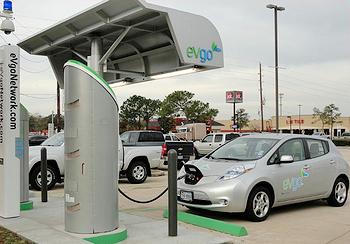
WASHINGTON, DC, June 11, 2013 (ENS) – The U.S. Energy Department today launched “eGallon,” a quick and easy online state-by-state system for drivers to compare the cost of fueling an electric vehicle with the cost of driving the same distance on unleaded regular gasoline. Find it here.
In Oregon, for instance, the eGallon price is about $0.96, meaning that a typical electric vehicle could travel as far on $0.96 worth of electricity as a similar vehicle could travel on a gallon of gasoline, which costs $3.74 in Oregon.
On average, fueling a car with gasoline costs roughly three times more than fueling with electricity.
In California, the eGallon price is $1.51 as compared with a gallon of gas, which costs an average of $3.98 in California.
In Virginia, the eGallon price is $1.04, while a gallon of gas costs $3.41, while in New York, the eGallon price is $1.80, while a gallon of gas costs $3.70.

Energy Secretary Ernest Moniz said, “Consumers can see gasoline prices posted at the corner gas station, but are left in the dark on the cost of fueling an electric vehicle. The eGallon will bring greater transparency to vehicle operating costs, and help drivers figure out how much they might save on fuel by choosing an electric vehicle. It also shows the low and steady price of fueling with electricity.”
“Not only can electric vehicles save consumers on fuel and reduce our dependence on oil, they also represent an opportunity for America to lead in a growing, global manufacturing industry,” said Moniz.
The eGallon comparison is made by calculating how much it would cost to drive an electric vehicle the same distance as a similar gasoline-powered vehicle could travel on a gallon of gasoline.
The eGallon price varies from state to state based on the price of electricity.
On Energy.gov/eGallon, consumers can see the latest eGallon price for their state and compare it to the price of gasoline.
Over time, drivers will notice that the eGallon price will be far more stable and predictable than gasoline prices. The eGallon price depends on electricity prices, which are very stable. Gasoline prices depend on the global oil market, which can be very unstable and are driven by unpredictable international events.
In the past two years, cost reductions and improvements in electric vehicle performance have had boosted EV sales. Sales of plug-in electric vehicles tripled in 2012, with more than 50,000 cars sold. Sales are growing again in 2013.
Last year, the Chevy Volt topped Consumer Reports’ annual owner-satisfaction survey for the second straight year, while the Tesla Model S was awarded the 2013 Motor Trend Car of the Year.
Almost 60 percent of the vehicle models sold in the U.S. last year were outsold by the Chevy Volt, putting the plug-in extended range model in the mainstream of the U.S. automobile market.
When plug-in electric vehicles are sold, the U.S. Environmental Protection Agency requires a window sticker that gives the miles per gallon equivalent, MPGe.
The eGallon does not replace this indicator, but is complementary to it, said the Energy Department Assistant Secretary David Danielson said today on a teleconference with reporters.
“These are two distinct ways to communicate value to American consumers,” Danielson said. “You can’t count them both at the same time. It’s become clear to us in conversations with clean cities around the country that that MPGe doesn’t communicate very well to consumers how much it’s costing them to drive an electric vehicle.”
“There’s no plan to replace the mpg equivalent,” he said. It’s well researched. The eGallon metric is complementary.”
Copyright Environment News Service (ENS) 2013. All rights reserved.
